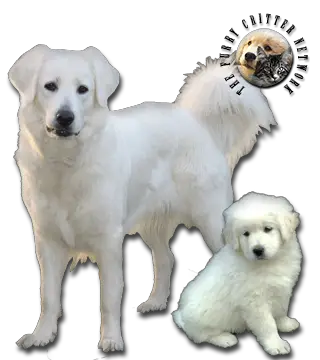History
The Slovak Cuvac, together with mountain sheep, the Hucul horse, and typical inhabitants of the mountains, formed the fundamental economic preconditions for the utilization of pastures for cattle. The inhabitants of the Slovak mountains were mostly free people who defended the frontiers and paid duties in sheep's cheese. The institution of these people was called "Valassky Opasok" and its center, until the abolition of serfdom, was Kosice. The members of this shepherd military system did their service on mountain meadows with their companions - the hearty white dog called the Slovak Cuvac.
A good watchdog, guard, shepherd and companion, the dog proved itself also in watching cattle, turkeys, and other domestic animals - as well as its master's household. Holiday makers and visitors to the mountains and spas took to this breed and began to carry it to the lowlands.The Slovak Cuvac is used on sheep farms and mountain ridges as well as homes and frontiers. He is boundlessly loyal and stout hearted. He resists every enemy - bears and wolves included. According to the time honored shepherd's tradition, he is always bred in white to be discernible from the beasts of the night.
This breed has been well documented as far back as the 17th century. However, as wolves slowly began to disappear from European mountains and modern herding practices were instituted, the Cuvac was faced with the prospect of being seen as a relic of the past. What few specimens were left in the 1950s were bred carelessly. Credit for reviving the breed and fixing characteristics is due Dr. Antonin Hruza, in cooperation with the veterinary school of Brno.
The registered breeding of the Slovak Cuvac was established in Czechoslovakia by Professor Antonin Hruza from the Veterinary Faculty in Brno on June 4, 1929. The Club of the Breeders of Slovak Cuvac was established in 1933 and a written standard was established and approved in 1964 Dr. V. Kurz). The basic breeding material came from the vicinity of Liptovska Luzna, Kokava and Vychodna as well as from Rachov in the Carpathians.
Behavior
The dog is known for its hardy constitution, sturdy frame and shaggy white coat. Its frame is massive, and his temperament is naturally lively, watchful, undaunted and alert. These dogs thrive best in an environment of a large family, children and livestock to care for. Farms and ranches make the best homes. These dogs are natural guard dogs. They are gentle and loyal with their family and possessions.
Function
Sheepdog, Guard Dog, Pet.






